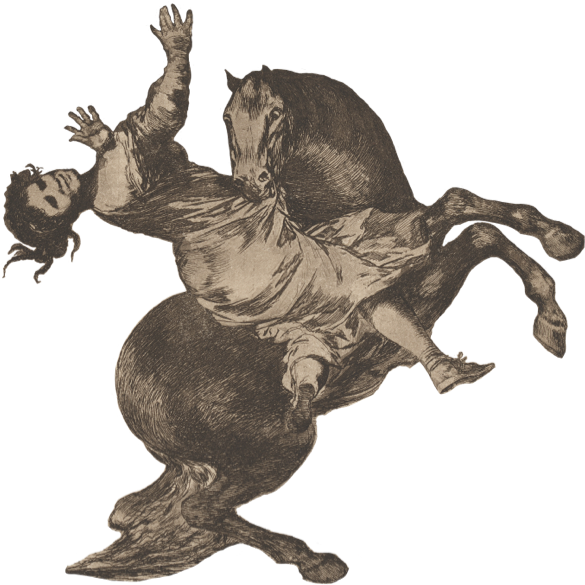Francisco GOYA y Lucientes
"What courage! (Que valor!)
plate 7, Los Desastres de la Guerra (The Disasters of War)", 1810–15, published by the Real Academia de San Fernando, Madrid, 1863, 1st edition
etching, aquatint, drypoint, burin and burnisher
13.5 x 18.6 cm (image) 15.3 x 20.5 cm (plate) 24.0 x 34.0 cm (sheet)
Gassier & Wilson 1000; Harris 127.III.1
Art Gallery of South Australia, Adelaide
South Australian Government Grant 1965 (6512G62)
Photo courtesy of AGSA
Francisco GOYA y Lucientes
Unhappy mother! (Madre infeliz!)
plate 50, Los Desastres de la Guerra (The Disasters of War), 1810–15, published by the Real Academia de San Fernando, Madrid, 1863, 1st edition
etching, burnished aquatint and drypoint
12.8 x 17.3 cm (image) 15.0 x 20.4 cm (plate) 24.1 x 33.9 cm (sheet)
Gassier & Wilson 1074; Harris 170.III.1
Art Gallery of South Australia, Adelaide
South Australian Government Grant 1965 (6512G105)
Photo courtesy of AGSA
Francisco GOYA y Lucientes
And there is no remedy (Y no hai remedio)
plate 15, Los Desastres de la Guerra (The Disasters of War), 1810–15, published by the Real Academia de San Fernando, Madrid, 1863, 1st edition
etching, drypoint, burin and burnisher
12.7 x 15.5 cm (image) 14.0 x 16.5 cm (plate) 24.2 x 34.0 cm (sheet)
Gassier & Wilson 1015; Harris 135.III.1
Art Gallery of South Australia, Adelaide
South Australian Government Grant 1965 (6512G70)
Photo courtesy of AGSA
Francisco GOYA y Lucientes
The consequences (Las resultas) 1814–15
preparatory drawing for Disasters of War, plate 72
red chalk
14.8 x 20.8 cm (sheet)
Gassier & Wilson 1119; Gassier II.220; Sánchez Cantón 162; Matilla & Mena Marqués 130
Museo Nacional del Prado, Madrid (D04267)
Photo © Photographic Archive. Museo Nacional del Prado, Madrid
Goya was sixty-one years old when Napoleon’s troops invaded Portugal and Spain in 1807 in order to seize control of the Iberian Peninsula, and to supplant the Bourbon ruler Ferdinand VII with the Bonaparte King Joseph I. This led to the Spanish uprising on 2 May 1808 and the subsequent Peninsular War, known in Spain as the War of Independence. The brutal six-year conflict was fought by the Spanish army, mercenaries and civilians organised into guerrilla groups.
In his series of eighty etchings, The Disasters of War, Goya portrays warfare with unprecedented realism. These images are far removed from conventional iconography focused on heroes, martyrs and glorious victories. Goya instead examines the human capacity for cruelty and barbarism, and represents the long-term consequences of war, including displacement, poverty and trauma. The series has three distinct parts: warfare and violence, the famine of 1811–12, and allegories of political repression in the period after the war when Ferdinand VII was restored to the throne and a new reign of terror began. Due to its critical and political content, the series remained unpublished until thirty-five years after Goya’s death.









